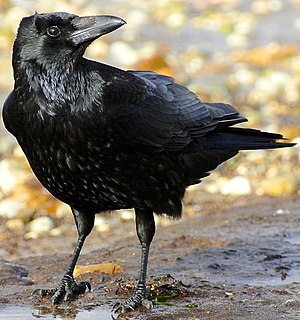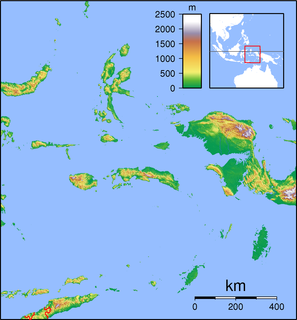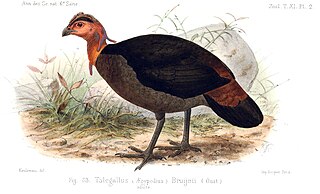Brushturkey, brush-turkey or brush turkey generally refer to birds in three genera in the megapode family, and sometimes to other species such as the Australian bustard:
Brushturkey, brush-turkey or brush turkey generally refer to birds in three genera in the megapode family, and sometimes to other species such as the Australian bustard:

A raven is one of several larger-bodied species of the genus Corvus. These species do not form a single taxonomic group within the genus.

D'Aguilar National Park is a national park in Queensland, Australia. It contains the D'Aguilar Range and is located along the northwest of the Brisbane metropolitan area. The park is traversed by the winding scenic Mount Nebo Road and Mount Glorious Road.

Galliformes is an order of heavy-bodied ground-feeding birds that includes turkey, chicken, quail, and other landfowl. Gallinaceous birds, as they are called, are important as seed dispersers and predators in the ecosystems they inhabit, and are often reared by humans for their meat and eggs, or hunted as game birds.
Turkey is a country in Eurasia.

The megapodes, also known as incubator birds or mound-builders, are stocky, medium-large, chicken-like birds with small heads and large feet in the family Megapodiidae. Their name literally means "large foot" and is a reference to the heavy legs and feet typical of these terrestrial birds. All are browsers, and all but the malleefowl occupy wooded habitats. Most are brown or black in color. Megapodes are superprecocial, hatching from their eggs in the most mature condition of any bird. They hatch with open eyes, bodily coordination and strength, full wing feathers, and downy body feathers, and are able to run, pursue prey, and in some species, fly on the same day they hatch.

A crow is a bird of the genus Corvus, or more broadly a synonym for all of Corvus. The word "crow" is used as part of the common name of species including:

Waigeo is an island in West Papua province of eastern Indonesia. The island is also known as Amberi, or Waigiu. It is the largest of the four main islands in the Raja Ampat Islands archipelago, between Halmahera and about 65 kilometres to the north-west coast of New Guinea. The Dampier Strait separates it from Batanta, and the Bougainville Strait from the Kawe Islands to its north-west. The "inner sea" that nearly cleaves the island in two is the Majoli Gulf.

The Australian brushturkey or Australian brush-turkey or gweela, also frequently called the scrub turkey or bush turkey, is a common, widespread species of mound-building bird from the family Megapodiidae found in eastern Australia from Far North Queensland to Eurobodalla on the south coast of New South Wales. The Australian brushturkey has also been introduced to Kangaroo Island in South Australia. It is the largest extant representative of the family Megapodiidae, and is one of three species to inhabit Australia.

The Waigeo brushturkey or Bruijn's brushturkey is a large brownish-black megapode with a bare red facial skin, red comb, maroon rump and chestnut brown below. There are two elongated red wattles on the back of the head and a long wattle on the foreneck. Both sexes are similar. The female has a smaller comb and no wattles.

The Australian bustard is a large ground dwelling bird which is common in grassland, woodland and open agricultural country across northern Australia and southern New Guinea. It stands at about one metre high, and its wingspan is around twice that length. The species is nomadic, flying to areas when food becomes plentiful, and capable of travelling long distances. They were once widespread and common to the open plains of Australia, but became rare in regions that were populated by Europeans during the colonisation of Australia. The bustard is omnivorous, mostly consuming the fruit or seed of plants, but also eating invertebrates such crickets, grasshoppers, smaller mammals, birds and reptiles.
Bush turkey may refer to:
The red-billed brushturkey also known as red-billed talegalla or Cuvier's brushturkey, is a large, up to 57 cm long, black megapode with bare yellow facial skin, a reddish orange bill, yellow iris, and orange feet. The head is covered with bristle-like black feathers. The sexes are similar.

The black-billed brushturkey, yellow-legged brushturkey or black-billed talegalla is a species of bird in the family Megapodiidae. It is found in the Aru Islands and New Guinea. Its natural habitat is subtropical or tropical moist lowland forest.

Talegalla is a genus of bird in the family Megapodiidae. First described by René Primevère Lesson in 1828, it contains the following species:
The collared brushturkey, brown-collared brushturkey, or red-legged brushturkey is a species of bird in the family Megapodiidae. It is found in the northern part of New Guinea. Its natural habitats are subtropical or tropical moist lowland forest and subtropical or tropical moist montane forest.

Tallegalla is a rural locality in the City of Ipswich, Queensland, Australia. In the 2016 census, Tallegalla had a population of 326 people.
Mediorhynchus is a genus of small parasitic spiny-headed worms. Phylogenetic analysis has been conducted on two known species of Mediorhynchus and confirmed the placement along with the related genus Gigantorhynchus in the family Gigantorhynchida. The distinguishing features of this order among archiacanthocephalans is a divided proboscis. This genus contains fifty-eight species that are distributed globally. These worms exclusively parasitize birds by attaching themselves around the cloaca using their hook-covered proboscis. The bird hosts are of different orders.
Wing-assisted incline running is a running behavior observed in living birds as well as a model proposed to explain the evolution of avian flight. WAIR allows birds to run up steep or vertical inclines by flapping their wings, scaling greater inclines than possible through running alone. The WAIR origin-of-flight hypothesis proposes that the nascent wings of theropod dinosaurs were used to propel the animal up slopes, such as cliffs or trees, in a similar manner to that employed by modern birds, and that powered flight eventually evolved from this usage. During its proposal, it was suggested that WAIR might have plausibly been used by feathered theropods like Caudipteryx to develop aerial flight.

Talegalla Weir is a locality in the Fraser Coast Region, Queensland, Australia. In the 2016 census, Talegalla Weir had a population of 123 people.